I’d been busy with other things in the first week of December and had missed covering the student occupation of the Senate House at London University, only hearing about it too late to easily change my plans. Living twenty miles from the centre of London also makes me rather less able to react at short notice than those living closer. So I didn’t witness the scenes of police brutality during the eviction around 8.30pm on Wednesday Dec 4th, though I did see some images of rough treatment taken by others, mainly by students who were either taking part or reporting on the occupation.
The following day I had arranged a meeting in the afternoon, and wanted to keep it, so although I covered two events earlier in the day, I missed the emergency protest at the university when the police again assaulted protesters. It wasn’t until the following afternoon – Friday – that I caught up with the what was happening at the University of London.
I was particularly sorry to have missed things earlier in the week, as the occupation had arisen out the student support for the low-paid workers on the campus, which is an ongoing story I have been covering for quite a while. But one person can’t be everywhere, and I also have to take things a little easier these days than when I was younger.
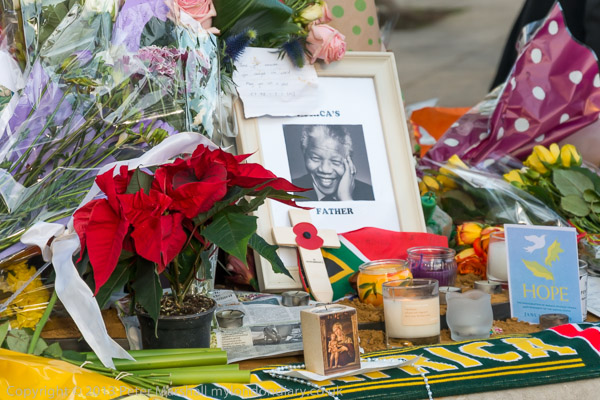
But before going to the university that Friday there were other events to cover in a very busy day for me. Late the pervious night I’d heard the news of Mandela’s death, and as an active member of the Anti-Apartheid Movement since the early 1960s (and still a member of its successor) I wanted to report on this, and started my day at the Mandela statue in Parliament Square. I took a few pictures of the flowers and other tributes and those coming to pay their respects before going on the the next event on my schedule – and returned to later in the day both there and to the South African High Commission in Trafalgar Square. You can see a few pictures in Tributes to Mandela.
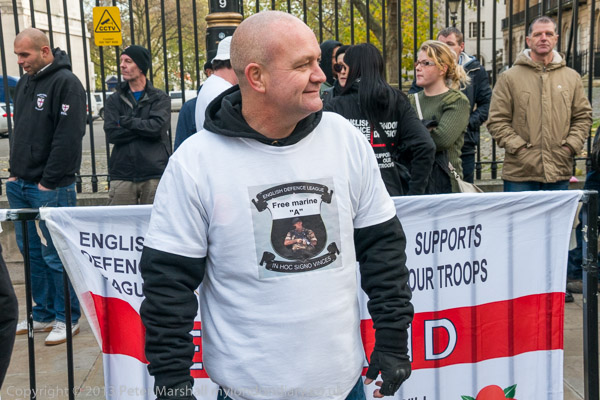
The next event in my diary was very different, with EDL supporters at Downing St in support of Marine Sergeant Alexander Blackman, who was due to be sentenced having been found guilty of the cold-blooded killing of a prisoner of war. The EDL were calling for him to be freed arguing that he acted under extreme pressure and that his victim was not a prisoner of war but terrorist. There didn’t seem to be much happening – as you can see in EDL Protest Supports Marine A, and having talked to a few people I left to go to another event that seemed to promise more interest.
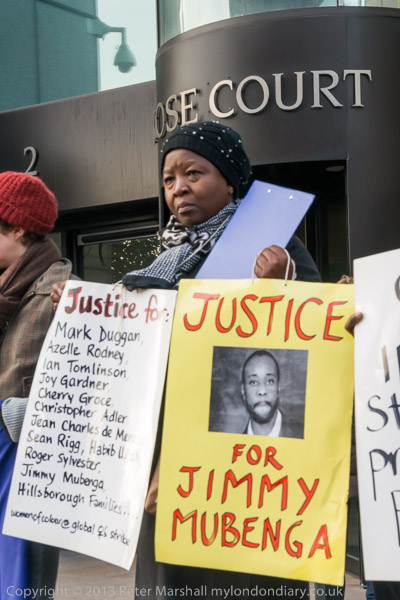
Another cause I’ve long had an interest in is the many unexplained deaths that occur in custody – in police stations, prison cells and closed mental wards. It’s difficult to be precise about numbers as what official statistics there are have been defined in a way that omits many cases.
Few of these deaths have been investigated in a timely or even professional manner, with the proper questions seldom being asked and at times with those officers involved refusing to cooperate with investigations. The official response has often been to knowingly issue misleading statements and to waste time before a flawed investigation by the IPCC following which the Crown Prosecution Service gives their standard response ‘not enough evidence to prosecute’. Since 1990 there have been 1433 deaths in custody, many under highly suspicious circumstances and there has been not a single successful prosecution.
The protest outside the CPS Offices at Rose Court came as an inquest jury was hearing evidence over the killing by police of Mark Duggan. The evidence given by police officers to the court appears to contradict that of other witnesses and of other evidence. The jury have yet to reach a verdict.
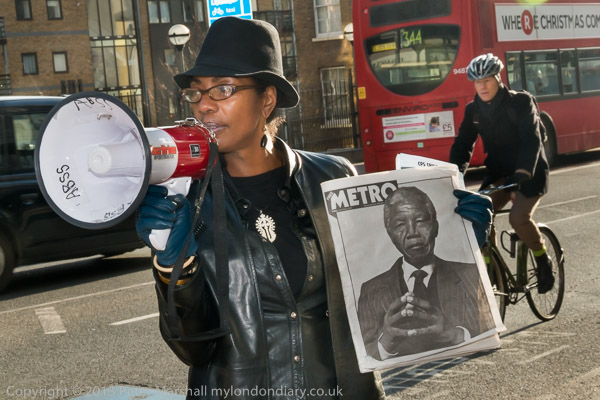
Marcia Rigg starts her speech at the Crown Prosecution Service with a tribute to Mandela
But among the speakers was Marcia Rigg, the sister of Sean Rigg, killed in Brixton Police Station in August 2008. The IPCC investigation took 18 months to decide the police had acted “reasonably and proportionately“. Almost four years after his death, following a considerable campaign by his family, the inquest was held and concluded that police used “unsuitable and unnecessary force” that “more than minimally” contributed to his death, highlighting the failures of the IPCC; a later independent external review found that they had failed to secure the crime scene, failed to prevent officers involved conferring and to ensure that all gave statements, had waited six months before interviewing them, had not examined the CCTV along with many other failures.
There is unfortunately little reason to assume that the treatment of Sean Rigg’s death was very different to that of many of the others who died in police custody; what made his case different was the strength and tenacity of the family in their continuing campaign to get to the truth. It still remains to be seen whether justice will be done. More pictures in Bereaved protest at CPS Failures.
I was sorry to have to leave this event before all of the speeches – there were others there who are still campaigning over the cases of their friends and relatives who have died. I was even sorrier when I arrived to find nothing happening – I found when I got home that evening it had been cancelled an hour or so earlier. One day I’ll have to move into the 21st century and get a phone that can keep me in touch while I’m away from home – my current antique mobile merely makes phone calls and just occasionally deigns to receive texts.
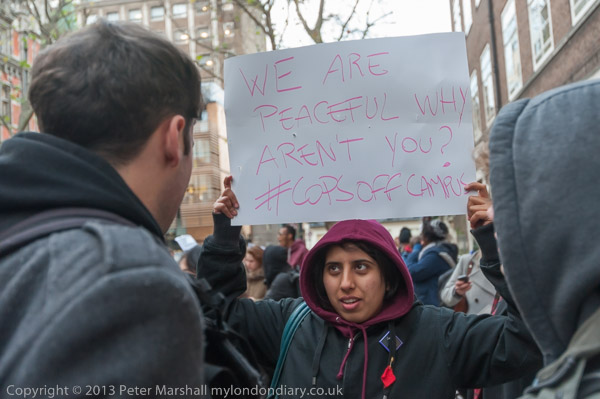
‘We Are Peaceful – Why Aren’t You #CopsOffCampus’ asks one of the placards, and it was a good question
It did mean that I was early for the next of the student protests, waiting outside the University of London Union in Malet St as people arrived for an emergency protest over the police actions on the previous two days. I’d had a few minutes to walk around the area and had seen police vans parked down many of the nearby streets, and there was one just a short distance from the ULU, as well as a number of blue-bibbed police liaison officers mingling with the crowd.
The liaison officers would have heard along with the rest of us that the organisers who spoke before the protest moved off intended to peacefully march around the streets and visit different parts of the university as a protest against police violence and the university management calling police on to the campus and also taking out an injunction against occupational protest. They made clear that they did not want there to be any violence and that they had no intention to occupy any part of the university in breach of the injunction.
It appears to have been a message that fell completely on deaf ears so far as the police were concerned. As the march approached the bottom of Malet St police appeared and formed a line across both ends of the street and the only side road. Students who tried to walk between the police in the line were ordered to stop and thrown roughly backwards.
It seemed clear that the police had intended to contain the students on Malet St, but had apparently failed to realise that there are several entrances onto the campus on the east side of the street. The students went through the main one and crossed the campus to Russell Square, where there were no police. They then went north and then west, passing the top of Malet St. I’d expected to see the police who had previously been there trying to stop them, but they had apparently followed the students rather than wait to stop them.
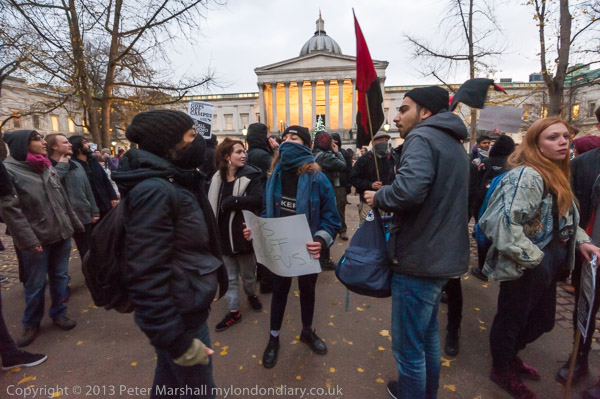
A group of around twenty police ran up behind as the back of the protest turned into Gower St, and obviously did not know what to do. Most of the protest had already passed and there were too few to make an effective cordon across the wide street. The students went on to briefly enter the courtyard of University College before heading down University St and then back down Huntley St towards their starting point.
By this time there seemed to be police vans going in several different directions and creating some chaos in the late afternoon traffic while having zero effect on the student protesters. It seemed to be a total waste of public money and a totally ineffectual over-reaction to a peaceful protest, which had caused far more disruption to Bloomsbury than the protest itself.
I left the students as they walked down into Torrington Square towards SOAS. I’d had enough of walking and had been on my feet for far too long and it was time to go home.
________________________________________________________
My London Diary : Buildings of London : River Lea/Lee Valley : London’s Industrial Heritage
All photographs on this and my other sites, unless otherwise stated are by Peter Marshall and are available for reproduction or can be bought as prints.
To order prints or reproduce images
________________________________________________________